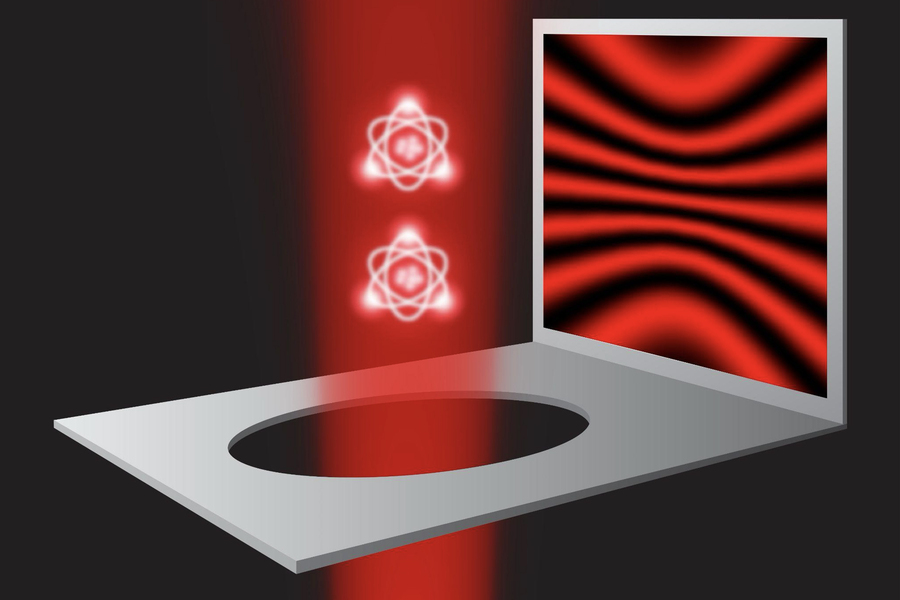Science
MIT Scientists Achieve Breakthrough in Double-Slit Experiment

Researchers at the Massachusetts Institute of Technology (MIT) have conducted the most precise demonstration of the iconic double-slit experiment to date. By using two individual atoms as slits, they successfully inferred the path of photons through subtle measurements of the atoms’ properties after scattering. Their results align with quantum theory, revealing interference patterns when no path was observed and distinct bright spots when the path was observed.
Reviving a Historic Experiment
The double-slit experiment, originally conducted by Thomas Young in the early 1800s, has continually fascinated scientists. The experiment’s setup is straightforward: light is directed towards a pair of slits, and the resulting pattern is observed on a screen. What emerges is counterintuitive. When unobserved, light behaves as a wave, producing an interference pattern resembling ripples on water. Yet, when the path of the light is measured, the interference pattern disappears, revealing two bright spots instead.
This shift in outcome depending on observation has profound implications for our understanding of reality. The debate around these implications has engaged notable physicists, including Albert Einstein and Niels Bohr. Einstein argued that observation introduces noise, suggesting that the slits could be mounted on springs to measure photon paths while preserving the interference pattern. In contrast, Bohr maintained that obtaining precise measurements would inherently obscure the interference pattern, supporting his principle of complementarity, which posits that quantum systems exhibit either wave-like or particle-like behavior, but never both simultaneously.
New Findings at MIT
Despite numerous iterations of the double-slit experiment consistently supporting Bohr’s theory, the presence of unavoidable noise in experiments left some ambiguity regarding the fundamental nature of these results. To mark the International Year of Quantum Science and Technology, physicists from Wolfgang Ketterle’s team at MIT sought to directly test Einstein’s thought experiment. They cooled over 10,000 rubidium atoms to near absolute zero and trapped them in a lattice created by lasers, allowing each atom to serve as an individual scatterer of light.
When a faint beam of light was directed through this lattice, a single photon could scatter off an atom. The challenge was to gather enough data, as the faintness of the beam limited the information collected per experiment. Hanzhen Lin, a PhD student involved in the research, stated, “This was the most difficult part. We had to repeat the experiment thousands of times to collect enough data.”
The team meticulously controlled the amount of information the atoms provided about the photon’s path by adjusting the laser traps to vary the “fuzziness” of the atoms’ positions. In scenarios where atoms were tightly trapped, their positions were well-defined, resulting in the emergence of interference fringes. Conversely, loosely trapped atoms exhibited greater positional uncertainty, allowing them to record interactions with photons, which collapsed the interference pattern into distinct bright spots.
This experiment builds upon prior work but marks a significant advancement by removing the traps while repeating the measurements. This approach goes beyond Einstein’s spring-mounted slit concept and confirms that the results remain unchanged without potential interference from the traps.
Thomas Hird, a physicist at the University of Birmingham who did not participate in the study, remarked, “I think this is a beautiful experiment and a testament to how far our experimental control has come. This probably far surpasses what Einstein could have imagined possible.”
The MIT research team aims to explore further by examining what occurs when two atoms are placed at each site in the lattice instead of one. “The interactions between the atoms at each site may give us interesting results,” Lin noted.
The findings from this innovative experiment are detailed in the journal Physical Review Letters, illustrating a significant step forward in the exploration of quantum behavior.
-

 Health3 months ago
Health3 months agoNeurologist Warns Excessive Use of Supplements Can Harm Brain
-

 Health3 months ago
Health3 months agoFiona Phillips’ Husband Shares Heartfelt Update on Her Alzheimer’s Journey
-

 Science2 months ago
Science2 months agoBrian Cox Addresses Claims of Alien Probe in 3I/ATLAS Discovery
-

 Science2 months ago
Science2 months agoNASA Investigates Unusual Comet 3I/ATLAS; New Findings Emerge
-

 Science1 month ago
Science1 month agoScientists Examine 3I/ATLAS: Alien Artifact or Cosmic Oddity?
-

 Entertainment5 months ago
Entertainment5 months agoKerry Katona Discusses Future Baby Plans and Brian McFadden’s Wedding
-

 Science1 month ago
Science1 month agoNASA Investigates Speedy Object 3I/ATLAS, Sparking Speculation
-

 Entertainment4 months ago
Entertainment4 months agoEmmerdale Faces Tension as Dylan and April’s Lives Hang in the Balance
-

 World3 months ago
World3 months agoCole Palmer’s Cryptic Message to Kobbie Mainoo Following Loan Talks
-

 Science1 month ago
Science1 month agoNASA Scientists Explore Origins of 3I/ATLAS, a Fast-Moving Visitor
-

 Entertainment2 months ago
Entertainment2 months agoLewis Cope Addresses Accusations of Dance Training Advantage
-

 Entertainment4 months ago
Entertainment4 months agoMajor Cast Changes at Coronation Street: Exits and Returns in 2025









